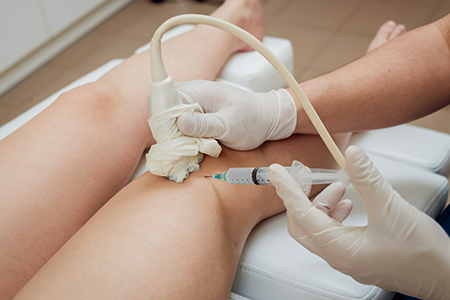 Chronic joint pain and arthritis can be debilitating, limiting mobility and impacting daily life. Platelet-Rich Plasma (PRP) therapy is an innovative, non-surgical treatment that harnesses the body's natural healing properties to reduce inflammation, relieve pain, and promote joint tissue regeneration.
Chronic joint pain and arthritis can be debilitating, limiting mobility and impacting daily life. Platelet-Rich Plasma (PRP) therapy is an innovative, non-surgical treatment that harnesses the body's natural healing properties to reduce inflammation, relieve pain, and promote joint tissue regeneration.
With extensive expertise in both physical therapy and orthopedic surgery, Dr. Jacob provides a comprehensive, patient-centered approach to managing joint conditions. His deep understanding of rehabilitation and surgical care allows him to customize PRP therapy for patients seeking a minimally invasive solution to joint pain, arthritis relief, or post-surgical recovery. Discover how PRP therapy can help restore joint function, alleviate arthritis symptoms, and improve mobility—so you can get back to doing what you love.
What is Platelet-Rich Plasma (PRP)?
Our blood consists of a liquid component known as plasma. It also consists of three main solid components which include the red blood cells (RBCs), white blood cells (WBCs), and platelets. Platelets play an important role in forming blood clots. They also consist of special proteins, known as growth factors, which help with our body's healing process. Platelet-rich plasma or PRP is a high concentration of platelets and plasma. A normal blood specimen contains only 6% platelets, while platelet-rich plasma contains 94% of platelets and 5 to 10 times the concentration of growth factors found in normal blood, thus greater healing properties.
Benefits of PRP Therapy
- Promotes Natural Healing - Uses the body's own regenerative properties to repair damaged tissues.
- Reduces Arthritis Pain - Helps decrease inflammation and discomfort in joints.
- Minimally Invasive & Nonsurgical - A simple injection procedure with minimal downtime.
- Delays the Need for Surgery - May slow the progression of joint degeneration and delay joint replacement.
- Enhances Recovery - Accelerates healing for muscle, tendon, and ligament injuries.
- Safe & Biocompatible - Uses your own blood, reducing the risk of allergic reactions or rejection.
What are the Indications for PRP Injections?
PRP is a relatively new method of treatment for several orthopedic conditions such as muscle, ligament, and tendon injuries; arthritis; and fractures. PRP injections can help alleviate painful symptoms, promote healing, and delay joint replacement surgeries.
Platelet-Rich Plasma Injection Procedure
Your clinician will draw blood, most typically from the large vein at your elbow or forearm. The blood is then spun in a centrifuge machine to separate the platelets from the remaining blood components. The affected part of your body is then injected with the platelet-rich plasma, with ultrasound guidance if needed.
Post-Procedure Care following PRP Injections
It is normal to feel some discomfort at the injection site for a few days after your procedure.
- You may use cold compresses to alleviate your symptoms.
- You will be instructed to stop any anti-inflammatory medications.
- You may resume your normal activities but should avoid any strenuous activities such as heavy lifting or exercises.
Risks and Complications of PRP Injections
There are very minimal risks associated with PRP injections. Some of the potential risks include:
- Increased pain at the injection site
- Infection
- Damage to adjacent nerves or tissues
- Formation of scar tissue
- Calcification at the injection site
Learn more about the PRP treatment used by Dr. Jacob here




